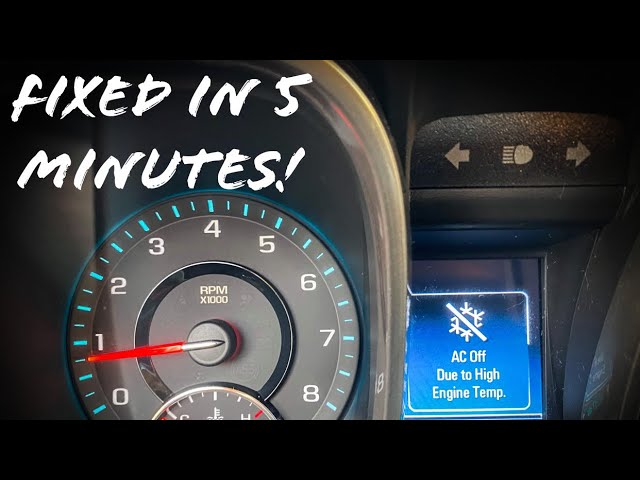
Experiencing your car’s air conditioning (AC) suddenly shutting off while driving can be alarming. While there are various reasons for this, one common culprit is a high engine temperature. This situation demands immediate attention as it signifies a potential issue that could lead to serious damage if ignored. Understanding why your AC might turn off due to overheating and the steps you should take is crucial for ensuring both your safety and the longevity of your vehicle.
This article will delve into the reasons behind this phenomenon, exploring the warning signs, potential causes, diagnostic procedures, and repair options available. By following the information provided, you can gain a better understanding of how to handle a high engine temperature situation and keep your car running smoothly.
High Engine Temperature Warning
Your vehicle is equipped with a sophisticated cooling system designed to maintain optimal engine temperatures. When this system malfunctions or faces excessive strain, the engine temperature rises beyond safe limits. This triggers a warning light on your dashboard, typically an image of a thermometer or an engine symbol accompanied by a warning message. Ignoring this warning can lead to severe consequences, including engine damage and costly repairs.
The severity of the overheating situation is often indicated by the intensity of the warning light or the frequency with which it flashes. A steady glow usually signifies a moderate temperature increase, while a flashing light indicates an urgent need to address the issue immediately. In some cases, you might also notice steam emanating from under the hood, further confirming that your engine is overheating.
AC Shutoff as a Safety Measure

Your car’s AC system relies on the engine’s cooling system for its operation. When the engine temperature rises excessively, the vehicle’s computer automatically shuts off the AC to prevent further strain on the already stressed cooling system. This safety measure aims to protect both the engine and the AC components from potential damage caused by overheating.
While it might seem inconvenient to lose your AC during a hot day, remember that this shutoff is a crucial safety feature designed to prevent more significant problems down the road. It’s important to address the underlying cause of the high engine temperature as soon as possible to avoid further complications and restore full functionality to your vehicle.
Causes of High Engine Temperature
Several factors can contribute to a high engine temperature, ranging from simple issues like low coolant levels to more complex problems with the cooling system itself.
- Low Coolant Level: The most common cause is simply running out of coolant. This can happen due to leaks, evaporation, or inadequate refilling during routine maintenance.
- Faulty Thermostat: The thermostat regulates the flow of coolant through the engine. If it malfunctions and remains closed, coolant circulation is restricted, leading to overheating.
- Cooling Fan Malfunction: The cooling fan helps dissipate heat from the radiator. A broken fan motor or faulty wiring can prevent proper airflow, causing the engine to overheat.
- Radiator Issues: A clogged radiator, damaged fins, or leaks in the radiator core can hinder efficient heat dissipation, leading to overheating.
- Water Pump Failure: The water pump circulates coolant throughout the system. If it fails, coolant flow is disrupted, resulting in a rapid increase in engine temperature.
Diagnosing the Problem

Identifying the root cause of your high engine temperature requires a thorough inspection by a qualified mechanic. They will typically start by checking the following:
- Coolant Level: The mechanic will visually inspect the coolant reservoir and check its level. If it’s low, they’ll top it off and investigate potential leaks.
- Thermostat Function: The thermostat can be tested to ensure it opens and closes properly at the correct temperature range.
- Cooling Fan Operation: They’ll verify that the cooling fan is running when the engine reaches operating temperature.
- Radiator Inspection: The radiator will be examined for leaks, clogs, or damage to the fins.
Additional diagnostic tools, such as pressure testing and infrared thermometers, may be used to pinpoint the exact source of the overheating issue.
Repair Options
Once the problem is diagnosed, your mechanic will recommend the appropriate repair options based on the severity of the issue.
- Coolant Top-Off/Leak Repair: If the problem is simply low coolant or a minor leak, topping off the coolant and repairing the leak may be sufficient.
- Thermostat Replacement: A faulty thermostat requires replacement with a new one that functions correctly.
- Cooling Fan Repair/Replacement: A malfunctioning fan motor can often be repaired, but in some cases, a complete fan assembly replacement might be necessary.
- Radiator Service: Depending on the severity of the damage, the radiator may require cleaning, repair, or replacement.
- Water Pump Replacement: If the water pump is faulty, it needs to be replaced with a new one to ensure proper coolant circulation.
Conclusion
Experiencing your car’s AC shutting off due to a high engine temperature is a serious matter that should not be ignored. Understanding the warning signs, potential causes, and necessary repair options can help you address the issue promptly and prevent further damage to your vehicle. Always prioritize safety by pulling over as soon as possible if you notice any overheating symptoms and consult a qualified mechanic for diagnosis and repair. Remember, regular maintenance and prompt attention to warning signs are crucial for keeping your car running smoothly and safely.
